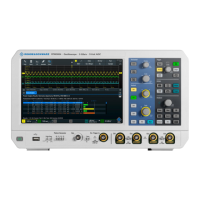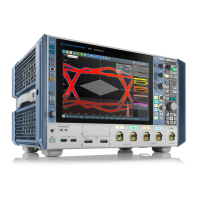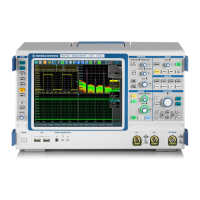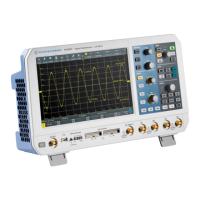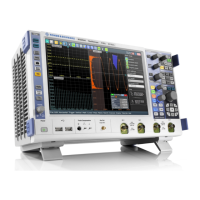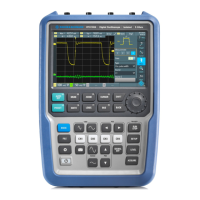Display
R&S
®
RTM20xx
54User Manual 1317.4726.02 ─ 01
4 Display
This chapter provides information on display configuration and display modes.
The default display is a waveform diagram with a time axis in x-direction and the signal
amplitudes displayed in y-direction - the Y(t) or time diagram. You can adjust the visibility
of diagram elements and waveform to your needs. See chapter 4.1, "General Display
Settings", on page 54 for details.
You can also display and configure XY-diagrams to combine the voltage levels of two
waveforms in one diagram. This display mode is described in chapter 4.2, "XY-Dia-
gram", on page 61.
Furthermore, you can zoom into waveforms to analyze the results in more detail. The
zoom display mode is described in chapter 4.3, "Zoom", on page 66.
In a Y(t)-diagram and in zoom mode, you can set markers to mark positions of interest
in the waveform. See chapter 4.4, "Markers", on page 71 for details.
In addition to zoom and XY-diagram modes, the following functional modes are available:
● FFT analysis, see chapter 8.2, "Configuring and Using FFT Calculations",
on page 111
● Mask testing, see chapter 9.2, "Working with Masks", on page 124
4.1 General Display Settings
General display settings adjust the visibility of diagram elements and waveforms.
The individual diagram elements can be shown or hidden:
●
Basic diagram elements: grid and crosshairs
●
Point of the trigger event
●
Channel cursors to mark the ground level and the DC offset
You can also adjust how the waveforms are displayed. The intensity and brightness of
the individual screen elements can influence the readability of the results. Depending on
which type of result you are interested in, e.g. frequency of occurance, time of occurance,
or amplitude of a specific value, different settings may be necessary to highlight that
aspect in the display.
The waveform display depends on the following criteria:
●
Waveform style: dots or line
●
Intensity: adjusts the optimal contrast of the display
Three settings can be changed to improve the contrast for the relevant display ele-
ments.
– The intensity of the waveform determines the strength of the signal in the diagram.
– The intensity of the background lighting determines the contrast of the signal.
– The intensity of the grid has an influence on the readability of the signal.
General Display Settings
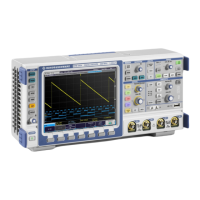
